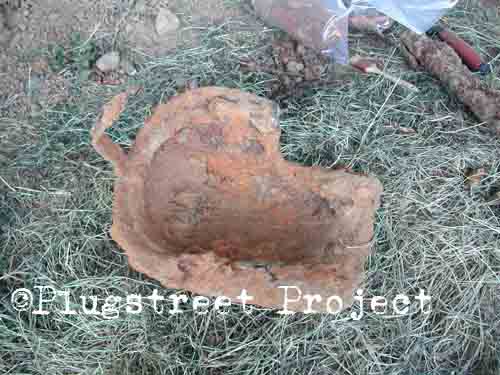The Plugstreet Archaeological Project
Elephant Mask

Elephant Mask.
"I finally got to sink a trowel in an archaeological excavation again, after a gap of a vast number of years, at St. Yvon in 2009. The short dig in March was sufficiently physically demanding to persuade me to volunteer to work on finds when I returned in August. This suited everyone, I think, as most people want to get down and dirty on a dig. Cleaning and cataloguing finds is not the favorite job, even though it is, of course, extremely important!
I did, however, want to do some digging so joined the motley crew for half a day on site. As a not very experienced archaeologist, I was assigned to a 'safe' spot - a corner of a trench which was a midden, or rubbish dump. Not too much that I could damage there… I happily trowelled away and was rather keen on a narrow piece of rusted curved metal that stuck put of the ground.
As I dug, it became clear that the piece protruding from the ground was bolted to a larger, also curved, piece of metal. This was definitely an object, but what? It looked like an oversized ladle, with a piece missing on one side! Encouraged by my fellow Irishwoman, Kat Fennelly, I gingerly prised the whole contraption out of the soil. Rod, the British Army expert who deals with any munitions found on the dig had jokingly remarked on the explosive potential of putting two Irishwomen in the same cutting - well, look at the result!
The crew gathered round to see what it was, and suggestions were bounced around. It was heavy, with an almost industrial feel to it. We held it horizontally, as I had found it in the ground. One idea was that it was agricultural, perhaps taken from the adjacent farm by the Germans and used for military purposes. An animal feeder, perhaps? Somebody made a joke about Darth Vader's helmet, but we dismissed that as it was too heavy to be worn.
In the end, no-one knew what this strange object was, and we phoned back to HQ in Mesen to warn the finds experts that a 'mystery object' was on its way. After our sandwich lunch, and the end of my half day on site, I carried it back in my car to the office where all the finds work was being done. I walked in with a grin on my face, and announced, "Here it is, the mystery object!" Rob and Egon took one look at it and said, in unison, "It's an elephant mask!" What??
The Elephant Mask after cleaning
It was a German sniper mask, called colloquially an 'elephant mask' because of the appearance it gave to its wearer. Those Darth Vader jokes were spot on, even though the thing weighed at least 10 kilos. It was rather like an oversize and very solid fencing mask. The narrow curved metal piece which had been sticking out of the ground was a strap to hook the mask over the top of the German sniper's pickelhaube - he would have had to remove the spike from it first. Cleaning revealed the two tiny eye-slits. The 'missing' piece was to accommodate the sniper's rifle lying along his right shoulder.
These masks had been designed by German surgeon August Bier who had treated many snipers who had their jaws, and other parts of their faces shot off when they took aim over the top of the trenches. He wanted to protect their heads but the masks were so heavy that they could only be worn when the sniper took his position. Apparently, they were made of half-inch Krupp steel. They weren't something to go strolling around in! Only 1500 of them are known to have been made, and only in 1915. My own guess is that they were simply too unwieldy to use and were not popular. Hence this example ended up in the rubbish tip in the trench.
So, mystery solved, and everyone quite pleased to have turned up a relatively rare object. The finds experts had recognised it as they had both seen one in the 'In Flanders Fields' Museum in Ieper. This one, along with the other finds from this 'No Man's Land' excavation, will go to the local Comines-Warneton museum which is planned to open in the coming years.
Audrey holding the Elephant Mask
As for me, I couldn't believe my luck, that in a half day's digging, I had found something so remarkable. It feels very bizarre to be pleased about finding a piece of lethal kit, but that is an aspect of working on this kind of excavation which places it apart from most others. The First World War is still - almost - within living memory and entailed the loss of millions of lives in conditions that were unimaginably horrible. It's not quite the same as digging up a Neolithic arrowhead. I've finished the dig feeling rather down both times - it's hard to distance oneself from the misery of what happened here. This is why the commemorative aspect of such a dig is important."
Audrey MacCready
Links:
- La Plaque Eléphant. in French
- More information on Elephant Masks English translation
|
Website and All Material © Copyright MMX - MMXVII - All Rights Reserved The Plugstreet Archaeological Project Website and Multimedia by Middleton House Productions |



